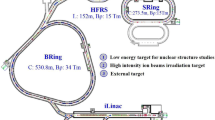Abstract
A noninvasive Ionization profile monitor (IPM) consisting of micro-channel plates, a phosphor screen and the optical-signal acquisition has been developed at the cooling storage ring of Heavy Ion Research Facility in Lanzhou (HIRFL-CSR). It makes the real-time profile measurements for the transverse beam cooling and orbit oscillation possible and efficient. This paper firstly describes all the IPM design criterions including the theoretical signal yield calculation, the space charge field and initial momentum evaluation, and the electrostatic field distortion simulation as well. In order to investigate the IPM performance, the beam profile measurements are done with different high voltage settings. Subsequently, some valuable beam experiments about the transverse electron cooling and orbit oscillation study are also presented. In the end, fast turn-by-turn profile measurements for the emittance blow-up research in a synchrotron are discussed. In cooperation with the newly deployed emittance instruments at the HIRFL-CSR injector, the IPM shows great prospects for the injection mismatch study, and potential values for the tune, dispersion and chromaticity measurements as well.














Similar content being viewed by others
References
J.W. Xia, W.L. Zhan, B.W. Wei et al., The heavy ion cooler-storage-ring project (HIRFL-CSR) at Lanzhou. Nucl. Instrum. Methods A 488, 11–25 (2002). https://doi.org/10.1016/S0168-9002(02)00475-8
T. Giacomini, S. Barabin, P. Forck et al., Development of Residual Gas Profile monitors at GSI. Am. Inst. Phys. Conf. Proc. 732, 286–293 (2004). https://doi.org/10.1063/1.1831159
D. Bodart, B. Dehning, S. Levasseur et al., Development of an Ionization Profile Monitor based on a pixel detector for the CERN Proton Synchrotron, in Proceedings of IBIC 2015, Melbourne, Australia (2015)
H.M. Xie, J.X. Wu, L.J. Mao et al., A residual gas ionization profile monitor developed for HIRFL-CSR. Nucl. Phys. Rev. 34, 773–778 (2017). https://doi.org/10.11804/NuclPhysRev.34.04.773
H.A. Bethe, Zur Theorie des Durchgangs schneller Korpuskularstrahlen durch Materie. Annalen der Physik 397, 325–400 (1930). https://doi.org/10.1002/andp.19303970303
M. Tanabashi et al. (Particle Data Group), Review of particle physics. Phys. Rev. D 98, 030001 (2018). https://doi.org/10.1103/PhysRevD.98.030001
J.F. Ziegler, M.D. Ziegler, J.P. Biersack, SRIM—the stopping and range of ions in matter (2010). Nucl. Instrum. Methods B 268, 1818–1823 (2010). https://doi.org/10.1016/j.nimb.2010.02.091
D.A. Bartkoski, Analysis, prototyping, and design of an Ionization Profile Monitor for the Spallation Neutron Source Accumulator Ring. Doctoral dissertation in Knoxville, The University of Tennessee (2013)
K. Schindl, Space charge. Beam Meas. (1999). https://doi.org/10.1142/9789812818003_0004
M. Sapinski, P. Forck, T. Giacomini et al., Ionization profile monitor simulations—status and future plans, in Proceedings of IBIC 2016, Barcelona, Spain (2016). https://doi.org/10.18429/JACoW-IBIC2016-TUPG71
V.V. Parkhomchuk, A.N. Skrinsk, Electron cooling: 35 years of development. Physics Uspekhi 43(5), 433–452 (2000). https://doi.org/10.1070/PU2000v043n05ABEH0007411
C. Böhme, I. Bekman, K. Reimers et al., Operational experience with the ionization beam profile monitor at COSY, in IPM 3rd Workshop Presentation, J-Parc, Japan (2018). https://doi.org/10.1023/A:1026053231074
F. Casper, Schottky signals for longitudinal and transverse bunched-beam diagnostics, CERN Accelerator School lecture, Dourdan, France (2008). https://doi.org/10.5170/CERN-2009-005.407
L.J. Mao, X.D. Yang, J. Li et al., Electron cooling experiments at HIRFL-CSR, in Proceedings of SAP 2014, Lanzhou, China, (2014)
M. Kuhn, Transverse emittance measurement and preservation at the LHC, CERN-THESIS-2016-149, Ph.D thesis, Humburg University (2016)
M.A. Fraser, Y. Dutheil, V. Forte et al., Matching studies between CERN PSB and PS through multi-turn beam profile acquisitions, in Proceedings of IPAC 2019, Melbourne, Australia (2019)
A.S. García, S.C.P. Albright, H. Bartosik et al., Systematic studies of transverse emittance measurements along the CERN PS Booster Cycle, in Proceedings of IPAC 2018, Vancouver, Canada (2018) https://doi.org/10.18429/JACoW-IPAC2018-TUPAF047
G.R. Lynch, O.I. Dahl, Approximations to multiple Coulomb scattering. Nucl. Instrum. Methods B 58(1), 610 (1991). https://doi.org/10.1016/0168-583X(91)95671-Y
J.C. Yang, J.W. Xia, G.Q. Xiao et al., High Intensity heavy ion Accelerator Facility (HIAF) in China. Nucl. Instrum. Methods B 317, 263–265 (2013). https://doi.org/10.1016/j.nimb.2013.08.046
Author information
Authors and Affiliations
Corresponding authors
Additional information
This work was supported by the National Natural Science Foundation of China (No. 11805250).
Rights and permissions
About this article
Cite this article
Xie, HM., Gu, KW., Wei, Y. et al. A noninvasive Ionization Profile Monitor for transverse beam cooling and orbit oscillation study in HIRFL-CSR. NUCL SCI TECH 31, 40 (2020). https://doi.org/10.1007/s41365-020-0743-7
Received:
Revised:
Accepted:
Published:
DOI: https://doi.org/10.1007/s41365-020-0743-7



